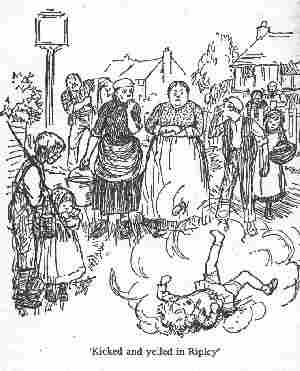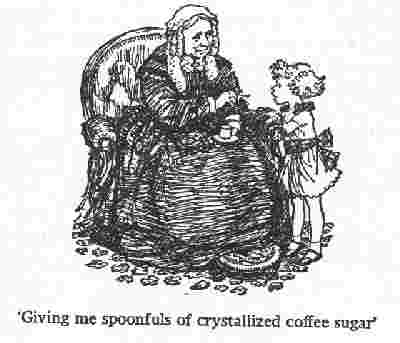
Figure 1.-Like all small boys, Ernest sometimes had temper tantrums. Here he throws one in the middle of the Ripley village common. He wears a dress with short socks and strap shoes. Notice the pinafores worn by the girls.

Ernest Shepard, the artist who illustrated Winnie the Pooh, in his childhood memoirs, Drawn from Memory provides a great deal of information about the clothes he and his brothers as well as other boys wore during the 1880s. Ernest was born in 1879 and both he and his brother wore dresses as little boys. Most of the book is set around the mid-1880s when Ernest was wearing Fauntleroy suits and sailor suits. Some of the drawings, however, show Ernest in dresses.
Shepard unfortunately does not mention wearing dresses as a small boy in the text of the book. Clearly he does remember because he renders his drawings in such detail. The dresses he wore appear relatively short with the hem above the knee. In the drawings he wears them with short white stocks and strap shoes. One of the drawings is clearly a summer image. The other drawing is indoors so the season is unclear. I do not know what he wore with dresses during the winter, presumably long stockings.
Shepard's failure to mention dresses in the text means that we have no clues about what he thought as a boy about wearing dresses. The fact that he does not bring it up perhaps suggests that it was not a major issue in his boyhood. But unfortunately we do not know.
I am not certain how long Ernest and his brother wore dresses. The drawings show him at about 4 years of age in dresses and then at about 6 years of age in sailor suits and Fauntleroy suits. Thus he was probably was breeched at about 5 years of age.
Earnest has longish hair as a small boy in dresses. It is not long shoulder-length hair, nor does it appear to be curled. Later photographs and drawings of him in Fauntleroy suits and sailor suits show him with somewhat shorter hair. and
One of the images Shepard includes shows him as a little boy throwing a temper tantrum in the middle of a village common. He is yelling and flailing around on the ground so violently that even one of his strap shoes goes flying in the air. He appears to be wearing short pantalettes. The fashion of wearing pantalettes was going out of style by the 1880s, but clearly they had not disappeared entirely. The pantalettes worn in the 1880s, however were much shorter than those worn earlier in the century.

Figure 2.--Earnest is depicted here at about 4 years of age with one of his aunts. He wears a white dress with short white socks and strap shoes. Note the plaid sash. |
Another of Shepard's drawings show him with one of his aunts. She is giving him a sugary treat. He wears a short white dress with white ankle socks with strap shoes. The dress is worn with a colorful plaid sash. He wears his hair over his ears, similar to the hair style he wore as a somewhat older boy with his Fauntleroy suit.
It is interesting to note that Ernest wore his dresses with bare legs. As a slightly older boy he always wore long stockings with his sailor suits and Fauntleroy suits. Even with his white sailor suit during the warm summer months, Ernest's and Cyril's legs are covered with long dark stockings. They much have been rather uncomfortable in the hot weather. It is not readily apparent why then the boys were bare legged when wearing dresses. I can only speculate. It might have been considered appropriate for very young boys and girls to be bare legged and wear short socks. As boys and girls got older it may have been considered necessary to begin wearing long stockings. Another factor could have been the pantalettes. The pantalettes were not worn with long stockings. Pantalettes were originally created to cover the legs and when dresses began to become shorter were worn by women and children to cover the legs to the ankles. By mid-century children were wearing shorter dresses and the length of the pantalettes began to shorten. By the 1860s, children wore knee length dresses with bare legs, but
pantalettes just slightly longer than the dress. Thus little boys and girls could wear pantalettes without long stockings.
